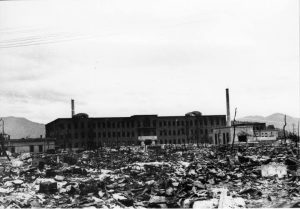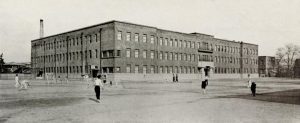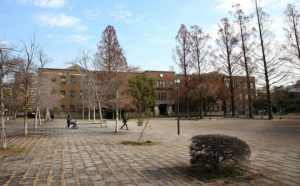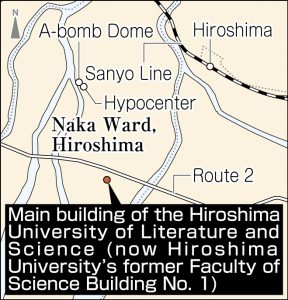Striving to fill voids in Hiroshima, evidence of victims remains—Records of A-bombing disaster, Part 4: Main building of Hiroshima University of Literature and Science
Jan. 6, 2022
Averting collapse, building utilized after war
by Kyosuke Mizukawa, Staff Writer
Hiroshima University’s former Faculty of Science Building No. 1, which is located in the Higashisenda-machi area of the city’s Naka Ward, is one structure that survived the atomic bombing. The walls of the three-story reinforced concrete building are covered by brick-like tiles. Toshio Kawamoto, who operated a photo studio in Hiroshima, took a photograph of the building around the end of 1945. The photo shows the building surrounded by rubble. Mr. Kawamoto, then a member of the Hiroshima Prefectural Police Department’s photography team, took photos to record the damage incurred by buildings and public transportation systems. Mr. Kawamoto died in 1968 at the age of 66.
Building’s interior almost completely destroyed by fire
The former Faculty of Science Building No. 1 was built in 1931 to serve as the main hall for the Hiroshima University of Literature and Science (now Hiroshima University). A photo taken before the war shows people playing tennis by the building. The grounds were composed of a cluster of education facilities, including Hiroshima Higher Normal School, the affiliated elementary school (later, the national school affiliated with the normal school), and the affiliated junior high school.
In June 1945, the third floor and part of the second floor of the university’s main building were requisitioned by the Chugoku Regional Superintendency-General, the government organization that was preparing for decisive fighting on Japan’s homeland. The building, located around 1.4 kilometers from the hypocenter, was exposed to the atomic bombing on August 6. The building’s interior was almost completely destroyed by the fires that arose in the aftermath of the bombing, although the building itself did not collapse. According to The Fire of Life and Death, Hiroshima University’s chronicle of destruction in the atomic bombing, 66 students and faculty members died by the end of 1945 after experiencing the bombing on their way to the university.
Other school buildings in the vicinity also suffered extensive damage. Shunichiro Arai, 90, a resident of Hiroshima’s Minami Ward, was a first-year student at the junior high school affiliated with Hiroshima Higher Normal School. He went on the school grounds the day after the atomic bombing and found no traces of his school’s wooden building. “I was shocked. I did happen to see some workshop machines poking out from among the rubble.” First-year students at the school had been mobilized to work in a farm village outside the city, but 10 students who remained behind in the city were killed in the bombing.
Closed when university relocated
The main building became the Faculty of Science Building No. 1 when Hiroshima University opened in 1949. After being utilized for educational purposes for so long, the building closed its doors when the university was relocated to nearby Higashihiroshima City in 1991.
Ownership of the building was later transferred without compensation changing hands to the Hiroshima City government. With a view to transforming the building into a center for the research of peace, the government has been holding deliberations with Hiroshima University and Hiroshima City University about relocation to the building of their respective peace research departments. Can all the memories of the atomic bombing engraved in the building be preserved and utilized for communicating our message of peace to the future? We find ourselves at a crossroads.
(Originally published on January 6, 2022)











